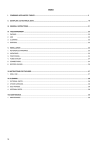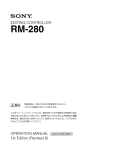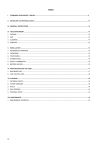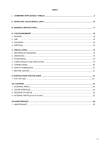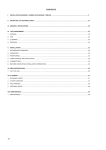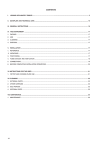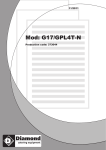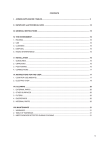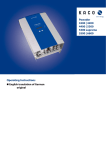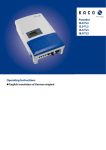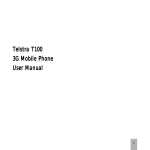Download User Manual - SharePoint
Transcript
CONTENTS I. JOINING APPLIANCES / TABLES .................................................................................................... 2 II. DATAPLATE and TECHNICAL DATA ............................................................................................... 15 III. GENERAL INSTRUCTIONS .............................................................................................................. 16 IV. THE ENVIRONMENT ......................................................................................................................... 17 1. PACKING ............................................................................................................................................ 17 2. USE ............................................................................................................................................. 17 3. CLEANING ......................................................................................................................................... 17 4. DISPOSAL ......................................................................................................................................... 17 V. INSTALLATION ................................................................................................................................. 17 1. REFERENCE STANDARDS ............................................................................................................... 17 2. UNPACKING ...................................................................................................................................... 17 3. POSITIONING .................................................................................................................................... 17 4. FUME EXHAUST ............................................................................................................................... 18 5. CONNECTIONS ................................................................................................................................. 18 6. SAFETY THERMOSTAT .................................................................................................................... 20 7. BEFORE COMPLETING INSTALLATION OPERATIONS .................................................................. 20 VI. INSTRUCTIONS FOR THE USER ..................................................................................................... 21 1. FRYER USE ....................................................................................................................................... 21 VII. CLEANING ....................................................................................................................................... 22 1. EXTERNAL PARTS ............................................................................................................................ 22 2. OTHER SURFACES ........................................................................................................................... 22 3. FILTERS ............................................................................................................................................. 22 4. IDLE PERIODS .................................................................................................................................. 23 5. CLEANING FRYERS WITH INTERNAL HEATING ELEMENTS (18L) ............................................... 23 6. INTERNAL PARTS ............................................................................................................................. 23 VIII. MAINTENANCE .............................................................................................................................. 23 1. MAINTENANCE ................................................................................................................................. 23 14 II. DATAPLATE and TECHNICAL DATA ATTENTION This manual contains instructions relevant to various appliances. See the dataplate located under the control panel to identify the appliance (see fig. above). T AB L E A - T e c h n ic a l d a ta o f g a s a p p lia n c e s M O DEL S T ECHNIC AL DAT A +9 FRGD1 GF0 4 00 m m +9FRGH2GF0 80 0 m m +9FRGD1J F0 4 0 0m m +9 FRGH2 J F0 8 00 m m +9 FRGD1 JFT 40 0 m m T a n k c ap a c ity Lt 15 1 5 +1 5 23 23 +23 23 ISO 7 /1 c o n n e c tio n Ø 1 /2 " 1 /2 " 1/2" 1 /2 " 1 /2 " No m in al h e at o u tp u t kW T y p e o f co n s tr u ct io n 14 28 20 40 19 A1 A1 A1 A1 A1 TABLE A - Technical data of electric appliances MODELS TECHNICAL DATA +9FRED1GF0 400m m +9FREH2GF0 800m m +9FRED1JF0 400m m +9FREH2JF0 800m m +9FRED1HFO 400m m +9FREH2HF0 800m m +9FRED1HFN 400m m +9FREH2HFN 800m m +9FRM D1HF5 400m m +9FRM D1HF6 800m m Tank capacity Lt 15 15+15 23 23+23 18 18+18 18 18+18 18 18+18 Pow e r s upply voltage V 400 400 400 400 400 400 230 230 400 440 Phas e s Nr. 3+N 3+N 3+N 3+N 3+N 3+N 3 3 3 3 Fr e que ncy Hz 50/60 50/60 50/60 50/60 50/60 50/60 50/60 50/60 50/60 50/60 M ax. total pow e r kW 10 20 18 36 16,5 33 16,5 33 15,5 15,5 Pow e r s upply cable s e ction mm2 2,5 4 4 10 4 10 10 25 4 4 15 III. GENERAL INSTRUCTIONS • Read the instruction manual carefully before using the appliance. • Keep the instruction manual for future reference. • RISK OF FIRE - Keep the area around the appliance free and clear of combustibles. Do not keep flammable materials in the vicinity of this appliance. • Install the appliance in a well-ventilated place to avoid the creation of dangerous mixtures of unburnt gases in the same room. • Air recirculation must take into account the air necessary for combustion 2 m³/h/kW of gas power, as well as the well-being of persons working in the kitchen. • Inadequate ventilation causes asphyxia. Do not obstruct the ventilation system in the place where this appliance is installed. Do not obstruct the vents or ducts of this or other appliances. sos • Place emergency telephone numbers in a visible position. • Installation, maintenance and conversion to another type of gas must only be carried out by qualified personnel authorised by the manufacturer. For assistance, contact an authorised service centre. Demand original replacement parts. • This appliance is designed for cooking food. It is intended for industrial use. Any use different from that indicated is improper. • This appliance is not intended for use by people (including children) with limited physical, sensory or mental abilities or without experience and knowledge of it, unless they are supervised or instructed in its use by a person responsible for their safety. • Personnel using the appliance must be trained. Do not leave the appliance unattended when in use. • Turn the appliance off in case of a fault or poor operation. • Do not use products (even if diluted) containing chlorine (sodium hypochlorite, hydrochloric or muriatic acid, etc.) to clean the appliance or the floor under it. Do not use metal implements to clean steel parts (wire brushes or Scotch Brite type scouring pads). • Do not allow oil or grease to come into contact with plastic parts. • Do not allow dirt, fat, food or other residuals to form deposits on the appliance. • Do not clean the appliance with direct jets of water. • The symbol given on the product indicates that it should not be considered domestic waste, but must be correctly disposed of in order to prevent any negative consequences for the environment and the health of people. For further information regarding the recycling of this product, contact the product agent or local dealer, the after-sales service or the local body responsible for waste disposal. L Warnings • Do not store or use gasoline or other flammable vapours, liquids or items in the vicinity of this or any other appliance. • Do not spray aerosols in the vicinity of this appliance while it is in operation. • Never check for leaks with an open flame. • The appliance is not suitable for a marine environment. Failure to observe the above can compromise the safety of the appliance. Failure to observe the above invalidates the warranty. 16 IV. THE ENVIRONMENT V. INSTALLATION 1. PACKING The packing materials are environmentally friendly and can be stored without risk or burned in an appropriate waste incineration plant. Recyclable plastic components are marked with: • • PE Polyethylene: booklet outer wrapping, instr uction bag, gas nozzle bag. Polypropylene: roof packing panels, straps. • Carefully read the installation and maintenance procedures given in this instruction manual before installing the appliance. Installation, maintenance and conversion to another type of gas must only be carried out by qualified personnel authorised by the manufacturer. Failure to observe the correct installation, conversion and modification procedures can result in damage to the appliance, danger to people, and invalidates the Manufacturer’s warranty. 1. REFERENCE STANDARDS PP Polystyrene foam: corner protectors. PS • • 2. USE Our appliances offer high performance and efficiency. To reduce electricity, water or gas consumption, do not use the appliance empty or in conditions that compromise optimum efficiency (e.g. with doors or lids open, etc.); the appliance must be used in a well-ventilated place, to avoid the creation of dangerous mixtures of unburnt gases in the room. When possible, preheat only before use. 3. CLEANING In order to reduce the emission of pollutants into the environment, clean the appliance (externally and when necessary internally) with products that are more than 90% biodegradable (for further information refer to section V “CLEANING”). 4. DISPOSAL Do not disperse in the environment. Our appliances are manufactured using more than 90% (in weight) recyclable metals (stainless steel, iron, aluminium, galvanised sheet, copper, etc.). Make the appliance unusable by removing the power cable and any compartment or cavity closing devices (when present) in order to avoid the risk of someone becoming trapped inside. Install the appliance in accordance with the safety regulations and local laws of the country where used. AUSTRALIA: this appliance shall be installed only by authorised persons and in accordance with the manufacturer’s installation instructions, local gas fitting regulations, local water supply regulations, AS5601-gas installation, health authorities and any other statutory regulations.. 2. UNPACKING ATTENTION! Immediately check for any damage caused during transport. • The forwarder is responsible for the safety of the goods during transport and delivery. • Inspect the packs before and after unloading. • Make a complaint to the forwarder in case of visible or hidden damage, reporting any damage or shortages on the dispatch note upon delivery. • The driver must sign the dispatch note: the forwarder can reject the claim if the dispatch note is not signed (the forwarder can provide the necessary form). • Unpack, taking care not to damage the appliance. Wear protective gloves. • Carefully remove the protective film from metal surfaces and clean any traces of glue with a suitable solvent. • For hidden damage or shortages becoming apparent only after unpacking, request the forwarder for inspection of the goods within and not later than 15 days of delivery. • Keep all the documentation contained in the packing. 3. POSITIONING • • • • • • • • Handle the appliance with care in order to avoid damage or danger to people. Use a pallet for handling and positioning. The installation diagram provided in this instruction manual gives the appliance overall dimensions and the position of connections (gas, electricity, water). Check that they are available and ready for making all the necessary connections. The appliance can be installed separately or combined with other appliances of the same range. The appliances are not suitable for recess-mounting. Leave at least 10 cm between the appliance and side or rear walls. Suitably insulate surfaces that are at distances less than that indicated. Maintain an adequate distance between the appliance and any combustible walls. Do not store or use flammable materials and liquids near the appliance. Leave an adequate space between the appliance and any side walls in order to enable subsequent servicing or maintenance operations. Check and if necessar y level the appliance after positioning. Incorrect levelling can cause appliance malfunctioning. 17 3.1. JOINING APPLIANCES • (Fig.1A) Undo the 4 fixing screws and remove the control panels of the appliances. • (Fig.1B) Remove the fixing screw nearest the control panel, from each side to be joined. • (Fig.1D) Bring the appliances together and level them by turning the feet until the tops match. • (Fig.1C) Turn one of the two plates inside the appliances 180º. • (Fig.1E) From inside the control panel of the same appliance, join them at the front side, screwing one M5x40 Hex Head screw (supplied) on the opposite insert. 3.2. FLOOR FIXING To avoid accidental tipping of built-in half-module appliances installed separately, fix them to the floor carefully following the instructions enclosed with the corresponding accessory (F206136). 3.3 INSTALLATION ON BRIDGE, CANTILEVER FRAME OR CEMENT PLINTH Carefully follow the instructions enclosed with the corresponding accessory. Follow the instructions enclosed with the optional product chosen. 5. CONNECTIONS • Any installation work or maintenance to the supply system (gas, electricity, water) must only be carried out by the utility company or an authorised installation technician. • Refer to the appliance dataplate for the product code. • See the installation diagram for the type and position of appliance connections. 5.1. GAS APPLIANCES IMPORTANT! This appliance is arranged and tested to operate with G20 gas 20mbar; to convert it to another type of gas, follow the instructions in par. 5.1.7. of this section. 5.1.1. BEFORE CONNECTING • • Make sure the appliance is arranged for the type of gas to be used. Otherwise, carefully follow the instructions given in the chapter: “Gas appliance conversion / adjustment”. Fit a rapid gas shut-off cock/valve ahead of each appliance. Install the cock/valve in an easily accessed place. 3.4 SEALING GAPS BETWEEN APPLIANCES Follow the instructions enclosed with the optional sealing paste pack. 4. FUME EXHAUST For Australia, ventilation must be in accordance with australian building codes and kitchen exhaust hoods must comply with AS/NZS1668.1 and AS 1668.2 4.1. TYPE “A1” APPLIANCES Position type “A1” appliances under an extractor hood to ensure removal of fumes and steam produced by cooking. 4.2 TYPE “B” APPLIANCES (in conformity with the definition given in the Installation Technical Regulations DIN-DVGW G634: 1998) Whenever the appliance dataplate specifies only type Axx, such appliances are not designed for being directly connected to a flue or fume exhaust pipe run to the outside. However, the same appliance can be installed under an extractor hood or similar forced extraction system for fumes. 4.2.1. CONNECTION FLUE • Remove the grille from the fume exhaust. • Install the connection flue, following the instructions supplied with the accessory (optional). 4.2.2. INSTALLATION UNDER AN EXTRACTOR HOOD • Place the appliance under the extractor hood (fig. opposite). • Raise the fume exhaust pipe without altering the section. • Do not install dampers. • The correct height of the exhaust pipe and the distance from the extractor hood must comply with the current regulations. • The end of the exhaust pipe must be at least 1.8 m from the support surface of the appliance. Note! The system must ensure that: a) the fume exhaust is not obstructed; b) the length of the exhaust pipe does not exceed 3 m. Use the adapter for connecting fume ducts of different diameters. • SUB CLAUSES 4.1/4.2 are not relevant for australian standard 18 • • • Clean the pipes to remove any dust, dirt or foreign matter which could block the supply. The gas supply line must ensure the gas flow necessary for full operation of all the appliances connected to the system. A supply line with insufficient flow will affect correct operation of the appliances connected to it. Caution! Incorrect levelling of the appliance can affect combustion and cause malfunctioning. 5.1.2. CONNECTION • Before connecting the appliance to the gas supply, remove the protective plastic cover from the appliance gas connection. • The appliance is arranged for connection on the bottom right side; for counter top models, gas connection can be made to the rear connection after removing the metal closing plug and screwing it tightly on the front one. • After installation, use soapy water to check connections for leaks. • The gas connection is male 1/2” BSP 5.1.3. SUPPLY PRESSURE CHECK Make sure the appliance is suitable for the type of gas present, according to that specified on the dataplate (otherwise, follow the instructions given in par. “Conversion to a different type of gas”). The supply pressure must be measured with the appliance working, using a manometer (min. 0.1 mbar). • Remove the control panel. • Remove retaining screw “A” from the pressure point and connect the manometer “O” (fig. 2A). • Compare the value read on the manometer with that given in table A; if the manometer gives a pressure outside the range of values in the table, do not start the appliance, and consult the gas company. 5.1.4 GAS PRESSURE REGULATOR 5.1.7.1 REPLACING MAIN BURNER NOZZLE (fig.3A / 3C) If the gas pressure is higher than that specified or is difficult to regulate (not stable), install a gas pressure regulator (accessory code 927225) in an easily accessed position ahead of the appliance. The pressure regulator should preferably be fitted horizontally, to ensure the right outlet pressure: • “1” connection side gas from mains. • “2” pressure regulator; • “3” connection side gas towards the appliance; The arrow on the regulator ( ) shows the gas flow direction. • • • • • Loosen nut “A” and unscrew injector “C”. Remove the injector and the aerator (fig.3A). Replace injector “C” with one corresponding to your gas supply as described in the table B. Injector diameter is shown in hundredths of a millimeter on the body. Insert injector “C” into aerator “E”. Fit the resulting assemblyinto its location and fully tighten the injector. 5.1.7.2 REPLACING PILOT BURNER NOZZLE • • • Undo screw coupling “H” and replace nozzle “G” with one suitable for the gas type (Table B, fig.3B). The nozzle identification number is given on nozzle body. Retighten screw coupling “H”. 2 5.1.7.3 REPLACING THE ADJUSTMENT SPRING OF THE PRESSURE REGULATOR 3 • 1 NOTE! These models are designed and certified for use with natural or propane gas. For natural gas, the pressure regulator on the header is set to 8" w.c. (20mbar). AUSTRALIA: the gas pressure regulator supplied with the appliance must be fitted to the appliance inlet. Adjust the test point pressure with one burner operating at maximum setting as follow: - 1.0 KPa for Natural gas - 2.5 KPa for Propane gas 5.1.5 GAS VALVE ADJUSTMENT • • • • OUTLET PRESSURE Remove the retaining screw from pressure point “B” and connect the manometer tube. Supply the appliance with the correct nominal gas pressure as given in corresponding par. 5.1.3. Turn the fryer on as indicated in the chapter “User Instructions”. Turn the outlet pressure adjustment screw of gas valve “D”, clockwise to increase it and anticlockwise to reduce it, adjusting the pressure as given in the nozzle table (table B). - - Replace the spring of the pressure regulator with one suitable for the gas pressure type given in table B (see handbook Appendix) as follows: Remove the seal cap, seal cap gasket, adjusting screw and the spring. Insert the new spring and replace the adjusting screw. Connect a pressure gauge to the appliance’s test point pressure (fig. 2A/2B). Ignite the appliance’s burners so to have the maximum gas consumption. Regulate the adjustment screw until the pressure gauge shows the working pressure value (section 5.1.4 Gas pressure regulator). Replace the seal cap and gasket and screw tightly closed. Remove the pressure gauge and close the test point pressure. Prior to operation, test the gas pressure regulator for leaks. 5.1.6. CHECKING THE PRIMARY AIR SUPPLY When the primary air supply is correctly adjusted, the flame does not detach with burner cold and there is no flashback with burner hot. • Undo screw “A” and position aerator “E” at distance “H” given on the panel B, retighten screw “A” and seal with paint (fig. 3A). 5.1.7. CONVERSION TO A DIFFERENT TYPE OF GAS The “technical data/gas nozzles” table B gives the type of nozzle to be used in place of those installed by the manufacturer (the number is stamped on the nozzle body). After replacing, carefully carry out the following check-list: C heck Ok 5.2. ELECTRIC APPLIANCES • b u r n e r n o z z l e /s r e p l a c e m e n t • c o r r e c t a d j u s tm e n t o f p r i m a r y a i r s u p p l y to b u r n e r /s • p i l o t n o z z l e /s r e p l a c e m e n t • m i n i m u m fl a m e s c r e w /s r e p l a c e m e n t • c o r r e c t a d j u s tm e n t p i l o t/s i f n e c e s s a r y • c o r r e c t a d j u s tm e n t o f s u p p l y p r e s s u r e ( s e e te c h n i c a l d a ta /g a s n o z z l e s ta b l e ) • a p p l y s ti c k e r ( s u p p l i e d ) w i th d a ta o f n e w g a s ty p e u s e d 5.2.1. ELECTRICAL CONNECTION (Fig. 4A-Table C). IMPORTANT! Before making the connection, check the compatibility of the dataplate specifications with mains voltage and frequency. • To access the terminal board, remove the appliance control panel by removing the fixing screws (fig. 4A 1-2). • Connect the power supply cable to the terminal board as shown in the wiring diagram supplied with the appliance. • Secure the power supply cable with a cable clamp. IMPORTANT! The manufacturer declines any responsibility if the safety regulations are not respected. 19 5.2.2. POWER SUPPLY CABLE Unless otherwise specified, our appliances do not come equipped with a power supply cable. The installer must use a flexible cable having characteristics at least equivalent to H05RN-F rubber-insulated type cables. Protect the cable section outside the appliance with a metal or rigid plastic pipe. 5.2.3. CIRCUIT BREAKER Install a circuit breaker ahead of the appliance. Contact opening distance and maximum leakage current must comply with current regulations. 5.3. EQUIPOTENTIAL NODE AND EARTH CONNECTION The appliance must be earthed; it must be included in an equipotential node by means of the screw located under the appliance frame at the front right. The screw is marked with . the symbol 5.4. ELECTRICAL CONNECTIONS FOR SOLAS VERSION Electrolux deep fat fryers Marine version are fitted with two thermostat: the working thermostat and the back-up fail safe thermostat; the built-in alarm system (alarm indicator light and audible signal-buzzer) is immediatly activated on backup thermostat trip while the deep fat fryer heating elements are automatically powered off, moreover the deep fat fryers interface with the galley fire control (MA2, MA3). NOTE! for connecting to the specific galley fire control board see the appropriate wiring diagram (pag. 104) 6. SAFETY THERMOSTAT Some of our appliance models use a safety thermostat that cuts in automatically when temperatures exceed a preset value, shutting off the gas supply (gas appliances) or the electricity supply (electric appliances). 6.1. RESET • Wait until the appliance has cooled down: a suitable temperature for resetting is approx. 90°C. • Press the red button on the body of the safety thermostat. IMPORTANT! If resetting entails the removal of a protective part (e.g. control panel) this must be carried out by a qualified technician. Tampering with the safety thermostat invalidates the warranty. 7. BEFORE LEAVING Check all connection for gas leaks with soap and water. Do not use a naked flame for detecting leaks. Ignite all burners both individually and combined to ensure correct operation of gas valves, burners and ignition. Turn gas taps to low flame for each burner, individually and separately, when satisfied with the appliance, please, instruct the user on the correct method of operation. In case the appliancefails to operate correctly after all checks have been carried out, refer to the authorised service provider. 20 “On” position 160 150 190 1 7 0 0 15 230 2 7 0 110 • • M N 0 15 • • 130 110 0 12 0 25 180/185°C NOTE! For cooking floured food, set the temperature to 170°C. A higher temperature does not improve the cooking result but will make the oil deteriorate more quickly (the residual flour in the oil tends to burn). IMPORTANT! During cooking, manually remove any residuals of food present in the oil. The prolonged presence of these residuals alters the taste and fragrance of the oil, reducing its useful life. For a quick and good measure of the degree of oil deterioration, use the litmus strips available on the market. 230 2 7 0 0 25 SET THE TEMPERATURE TO: 175/180°C 170°C 180 1 70 0 19 210 Foods that do not disperse pollutants in the oil Breaded foods Floured foods “Pilot on” position 1 7 0 TYPE OF FRYING: “Off” position “Pilot ignition” position 190 SETTING FRYER TEMPERATURE Knob M: 210 General precautions • The appliance is intended for industrial use and must be used by trained personnel. • Do not use the appliance for long periods when empty or in conditions that compromise optimum efficiency. If possible, pre-heat the appliance immediately before use. • This appliance must only be used for the express purpose for which it is designed, i.e. frying foods in oil or solid fat. Any other use is to be considered improper. • Before introducing oil in the tank, make sure it does not contain water. • Pour the oil in the tank up to the max. level indicated by the special reference notch situated on the rear wall of the tank. • When using solid fat, dissolve the fat separately and then pour in the tank. Do not leave fat in the tank at the end of cooking. • Restore the oil bath whenever it falls below min. level, marked by the special reference notch. (danger of fire); • Particularly voluminous and non-drained foods can cause sprays of hot oil. • Place the basket with food to be cooked, slowly in the boiling oil, making sure that the froth formed does not spill over the edge of the tank. If this occurs, stop dipping the basket for a few seconds. Ignition The thermostatic valve control knobs have the following positions: 0 1. FRYER USE 1.1. GAS MODELS 14 VI USER INSTRUCTIONS Turn knob “M” anticlockwise from position to position . Press down knob “M” and turn it to position to light the pilot. If the pilot does not light, repeat the operation until it does. Then, hold knob “M” down for about 20 seconds, release it and check that the pilot flame remains lit; otherwise, repeat the entire operation. In case of emergency the pilot can also be lit manually by opening the door and bringing a flame to it, keeping knob “A” pressed in the “pilot ignition” position for the time necessary. Important! If the pilot burner accidentally goes out, the valve has a safety device that prevents immediate re-lighting. Wait 60 seconds for the release of knob “M”. To light the main burner, turn knob “M” anticlockwise from position to position . WARNING: THE KNOB “M” MUST REMAIN IN POSITION WHEN OPERATING THE FRYER. DO NOT OPERATE THE FRYER WITH KNOB “M” IN ANY OTHER POSITION. • To adjust the temperature turn knob “N” to the desired value. Switching off • Turn knob “M” clockwise from position to position . • Press the knob down fully and turn it to position ; release it and turn it to position . 21 1.2. ELECTRIC MODELS VII CLEANING C A CAUTION! Before carrying out any cleaning operation, disconnect the appliance from the mains power supply. 0 18 105 5 230 175 2 190 7 0 210 0 25 1 7 115 0 0 15 110 5 0 7 190 2 12 5 165 15 230 210 0 25 1 7 0 135 145 0 15 110 B Ignition • Turn the knob of Thermostat “A” to the value corresponding to the desired cooking temperature. • Lighting up of green indicator “B” signals that the power is on. Lighting up of yellow indicator “C” signals that the heating elements are on; it goes off when the set temperature is reached. NOTE! When using a fryer with heating elements inside the tank, pay particular attention when handling them, using the special support bracket “D”. For greater safety, the presence of a microswitch cuts off the electrical power when the heating elements “E” are raised. D E Switching off • Turn the knob of thermostat “A” to position “0”. 1.3. DRAINING OIL • Switch the fryer off; • open the drain cock, slowly turning handle D anticlockwise and paying maximum attention to avoid contact with hot oil; • close the drain cock, turning handle D clockwise. For better performance of the appliance, regularly change the oil used. Overusing an oil reduces its flashpoint and increases its tendency to boil suddenly. D 22 1. EXTERNAL PARTS SATIN-FINISH STEEL SURFACES (daily) • Clean all steel surfaces: dirt can be easily removed as soon as it forms. • Remove dirt, fat and food residuals from steel surfaces when cool, using soapy water, applied with or without detergent with a cloth or sponge. Dry the surfaces thoroughly after cleaning. • In case of stubborn dirt, fat or food residuals, wipe the cloth/sponge with the grain of the satin finish and rinse often: rubbing in a circular motion, combined with the particles of dirt deposited on the cloth/sponge, could damage the steel’s satin finish. • Iron objects could ruin or damage the steel: damaged surfaces become dirty more easily and are more liable to corrode. • Have the satin finish repaired if necessary. SURFACES BLACKENED BY HEAT (when necessary) Exposure to high temperatures can cause the formation of dark marks. These do not constitute damage and can be removed by following the instructions given in the previous paragraph. 2. OTHER SURFACES HEATED TANKS/CONTAINERS (daily) Clean the appliance tanks or containers using boiled water, with the addition of soda (degreasing) if necessary. Use the accessories (optional or supplied) specified in the list to eliminate food deposits. TANKS AND COLLECTION DRAWERS (even several times a day) Remove any grease, oil, food residuals, etc., from trays, drawers and containers in general used for collection. Always clean the containers at the end of the day. Empty the containers during use of the appliance, when they are nearly full. CAUTION! With electric appliances, make sure no water comes into contact with electric components: water penetration can cause short circuiting and dispersion, tripping the appliance’s protection devices. 3. FILTERS Use of filters for oil increases the life of the oil, and in case of reuse guarantees better cooking of food. To clean, remove the filter from its seat: if the filter is dirty with grease, wash it with degreasing soap, then rinse and dry; refit the filter in its seat. Replace the filter when it is deteriorated. 4. IDLE PERIODS 1.1 BRIEF TROUBLESHOOTING GUIDE (gas model) If the appliance is not going to be used for some time, take the following precautions: • Close any cocks or main switches installed ahead of the appliances. • Rub all stainless-steel surfaces vigorously with a cloth moistened with vaseline oil in order to form a protective film. • Periodically air the premises. • Have the appliance checked before using it again. • In order to avoid too rapid evaporation of accumulated moisture and consequent breaking of the element, when starting up again leave electric appliances on minimum power setting for at least 45 minutes. Even with normal use of the appliance, malfunctions can possibly occur. 5. CLEANING FRYERS WITH INTERNAL HEATING ELEMENTS (18 LITRES) Clean the tank, operating as follows: • wait until the oil has cooled; • drain the oil from the tank by means of the special cock; • lift the heating element unit “A” (see figure) by means of support bracket “B”; • tilt the support bracket and place it in the tank expansion zone “C”. In this position the power to the heating element unit is cut off by a microswitch. • Carefully clean the tank and heating elements, taking particular care with the latter so as not to damage the appliance. - The pilot burner does not light. Possible causes: • The igniter is not properly fixed or connected. • The electric ignition or igniter cable are damaged. • Insufficient pressure in gas pipes. • Blocked nozzle. • Faulty gas valve - The pilot burner goes out when the ignition knob is released. Possible causes: • The thermocouple is not connected properly or the safety thermostat cables are disconnected. • The pilot burner is not heating the thermocouple sufficiently. • Safety thermostat cut in or faulty. - The pilot burner is still lit but the main burner does not light. Possible causes: • Insufficient pressure in gas pipes. • Nozzle blocked. • Faulty gas valve. • Faulty thermostat operation. - The temperature cannot be adjusted. Possible causes: • Thermostat bulb damaged. • Faulty thermostat. INSTRUCTIONS FOR REPLACING COMPONENTS (to be carried out only by a specialized A B installation technician) - Gas valve • Undo the fixing screws and remove the control panel. • Unscrew the pilot burner pipe and the thermocouple. • Undo the screws fixing the flange to the valve. • Remove the valve gas supply tube clamping. C 6. INTERNAL PARTS (every 6 months) IMPORTANT! Operations to be carried out exclusively by specialized technicians. • Check the condition of internal parts. • Remove any deposits of dirt inside the appliance. • Check and clean the flue system. N.B.: In certain ambient conditions (e.g. intensive use of the appliance, salty environment, etc.) cleaning should be more frequent. VIII MAINTENANCE 1. MAINTENANCE - Thermocouple, safety thermostat, ignition device • Remove the control panel and replace the elements. • To replace the thermostat, remove the gasket between the tank and bulb clamping (replacement from door compartment and control panel). - Main burner, pilot burner, pilot nozzle and main nozzle • From door compartment. - Main air supply adjustment • From door compartment. 1.2 MAINTENENCE SCHEDULE • It is reccommended the appliance is inspected and serviced by an authorized person at least every 12 months. For this purpose it is reccommended to draw up a maintenece contract. AUSTRALIA For service and spare parts, please contact: Electrolux - Tom Staddart Pty Ltd Zanussi - JL Lennard Pty Ltd All the components requiring maintenance are accessible from the front of the appliance, after removing the control panel and front panel. Disconnect the power supply before opening the appliance 23










